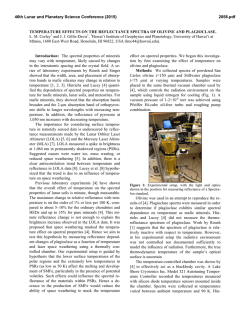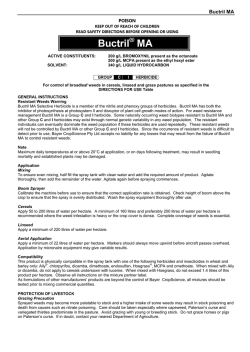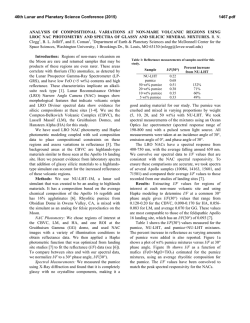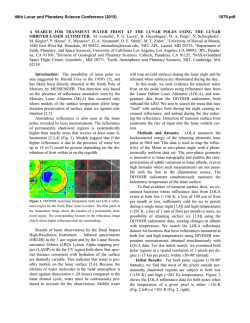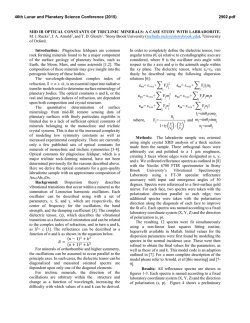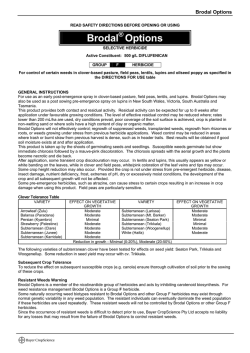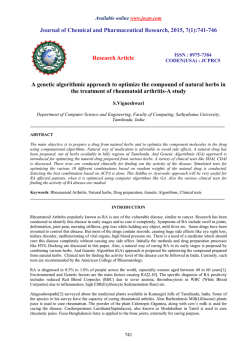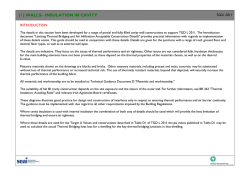
Leaf Spectral Reflectance for Nondestructive
Leaf Spectral Reflectance for Nondestructive Measurement of Plant Nutrient Status J.R. Davenport1, 2, E.M. Perry3, N.S. Lang4, and R.G. Stevens2 ADDITIONAL INDEX WORDS. apple, potato, grape, nitrogen, leaf, petiole, NDVI SUMMARY. The ability to monitor plant nutrient status of high value horticultural crops and to adjust seasonal nutrient supply via fertilizer application has economic and environmental benefits. Recent technological advances may enable growers and field consultants to conduct this type of monitoring nondestructively in the future. Using the perennial crop apple (Malus domestica) and the annual crop potato (Solanum tuberosum), a hand-held leaf reflectance meter was used to evaluate leaf nitrogen (N) status throughout the growing season. In potato, this meter showed good correlation with leaf blade N content. Both time of day and time of season influenced leaf meter measurement, but leaf position did not. In apple, three different leaf meters were compared: the leaf spectral reflectance meter and two leaf greenness meters. Correlation with both N rate and leaf N content were strongest for the leaf reflectance meter early in the season but nonsignificant late in the season, whereas the leaf greenness meters gave weak but significant correlations throughout the growing season. The tapering off of leaf reflectance values found with the hand-held meter is consistent with normalized difference vegetation index (NDVI) values calculated from satellite images from the same plots. Overall, the use of leaf spectral reflectance shows promise as a tool for nondestructive monitoring 1 To whom reprint requests should be addressed. E-mail: [email protected] 2 Department of Crop and Soil Sciences, Washington State University, 24106 N. Bunn Road, Prosser, WA 99350. 3 Center for Precision Agriculture Systems, Washington State University, 24106 N. Bunn Road, Prosser, WA 99350. 4 Department of Horticulture, Michigan State University, A322 Plant and Soil Sciences Building, East Lansing, MI 48824. ● Jan2005HT.indb 31 January–March 2005 15(1) of plant leaf status and would enable multiple georeferenced measurements throughout a field for differential N management. T he underlying concept of using leaf spectral reflectance to measure plant stress is based upon the differential reflectance of light by plants [i.e., plants generally utilize (absorb) visible light in the blue and red wavelengths, and reflect light in the green and near infrared portions of the light spectrum]. Various technologies have been used to exploit this basic relationship, including color infrared film, digital cameras, multispectral sensors on airplanes and satellites, and hand-held sensors measuring light in narrow wavebands (wavelength intervals). Plant reflectance measurements through remote sensing have been used to quantify canopy vigor (e.g., Peters et al., 2003; Sudbrink et al., 2003; Wang et al., 2003) as well as nutrient and water availability (e.g., Bausch and Duke, 1996; Osborne et al., 2002). Since the early 1990s there has been a trend toward using specific narrow wavebands to better characterize plant stress from nutrient deficiency and other sources. One example is the use of narrow wavebands to measure the so-called chlorophyll red-edge, which defines the rapid increase in reflectance just beyond the red spectral region; this reflectance feature has been shown to be highly correlated to plant nitrogen availability (e.g., Daughtry et al., 2000; Lamb et al., 2002; Zhao et al., 2003). The different technologies available provide information at different spatial and spectral (wavelength) scales. Hand-held spectroradiometers provide reflectance data by wavelength, with wavelength intervals as precise as 1 nm (e.g., FieldSpec Pro; Analytical Spectral Devices, Boulder, Colo.). These instruments are typically used as research tools to develop and test methods for specialized sensors. Some specialized handheld sensors have been developed as a result of reflectance monitoring research. For example, the Field Scout CM 1000 (Spectrum Technologies, Plainfield, Ill.) measures reflectance in the red and near-infrared regions and estimates plant chlorophyll concentrations. Multispectral imaging systems measure reflectance in the same regions to estimate the amount of photosyn- thetic plant matter contained in a given pixel; for measurements over a closed canopy these measurements would be analogous to the handheld measurements. Commercial satellite imagery is now available at a spatial resolution of 10.8 ft2 (1 m2) per pixel or smaller (Space Imaging, Inc., 2004). Satellite imagery costs range from nominal distribution costs for public data to over $8.09/acre ($20/ha) for commercial sources with high levels of processing included (e.g., map coordinates). An eventual application of these technologies might be to combine handheldsensors for single plant measurements with synoptic view imagery to provide measures of variability from plant to plant, and across entire fields. In this paper we explore the potential of leaf spectral reflectance monitoring for two cases of crop characterization. Reflectance monitoring via handheld sensors is evaluated for assessment of N status in an annual cropping system (potato) and a perennial system (apple). In the next section we will describe the sensors used and the overall approach to measurements. We then present each of the cases separately, describing the experimental methods and discussing results. In the final section, we discuss what has been learned from these cases and the implications for reflectance sensors in horticulture. Relating these results to findings from previous work, we then examine the use of reflectance monitoring to address the spatial variability of plant conditions, using an example of ultraviolet (UV) light and water stress response in juice grape (Vitis labrusca). Sensors used and measurement approaches The Minolta SPAD 502 (SPAD; Spectrum Technologies) and the CCM 200 (OptiSciences, Tyingsboro, Mass.) use transmittance of light through leaf tissue at two wavelengths to estimate chlorophyll. The sensor is attached to the upper surface of a leaf to make a single, simultaneous measurement of both wavelengths. Measurements are affected by the selection of a given leaf within the canopy and the measurement location on the leaf surface. For our studies, meters were attached between the leaf mid-vine and leaf edge with the upper leaf surface pointing upward. The Field Scout CM 1000 mea31 12/6/04 4:34:40 PM WORKSHOP sures reflected light at 700 and 840 nm to estimate chlorophyll. The illumination source is the sun, but changing ambient light conditions are corrected for by the sensor. The sensor sample area is a function of the distance between the sensor and the target. For these studies, the sensor was positioned about 18 inches (45.7 cm) from the upper leaf surface, producing an effective sample diameter of approximately 1 inch (2.5 cm). CASE 1: N AVAILABILITY IN POTATO Methods In 2001 and 2002 ‘Ranger Russet’ potato was planted in a Quincy fine sand (fine, mesic, Typic Torripsamment) near Paterson, Wash. (lat. 45°55´N, long. 119°35´ W). Plots four rows wide and 32 ft (9.8 m) long were established in a randomized complete-block design, with four different total seasonal N rates [0, 150, 300, and 400 lb/acre (0, 168.1, 336.2, 448.3 kg·ha–1)], using urea and were replicated four times. To be consistent with standard grower practices in the area (Lang et al., 1999), 35% of the urea was applied as granular material at planting and incorporated with the planting. The remaining 65% was applied as liquid urea in simulated fertigation (Davenport and Bentley, 2001) across nine equal rate applications beginning at tuber initiation. All plots were provided phosphorus (P) and potassium (K) at rates consistent with current standards based on soil testing (Lang et al., 1999). Irrigation and pest control were provided to minimize plant stress. Weekly, from row closure through 2 weeks preharvest, the fifth fully expanded leaf from 50 plants per plot was collected between 0800 and 0900 HR. Petiole tissue was analyzed for nitrate nitrogen (NO3-N) by water extracting dried ground tissue and analyzing colorimetrically (Mulvaney, 1996) on an EnvironFlow-3000 (O-I Corp, College Station, Texas). In 2002 the leaf blade tissue was also retained and dried ground sample was analyzed for total N using dry combustion (Bremner, 1996) on a LECO C-N–S analyzer (St. Joseph, Mich.). Concurrent with tissue collection, the CM 1000 was used to measure leaf spectral reflectance on the fifth fully expanded leaf of three plants per plot (Lang et al., 1999). In 2002, a companion test was conducted on the same site to evalu32 Jan2005HT.indb 32 ate the effect of using different leaf positions on leaf spectral reflectance readings (leaf position test). In the uniformly fertilized (300 lb/acre N) border rows at the Paterson site, leaf spectral reflectance was measured with the CM 1000 on individual leaves from the smallest fully expanded leaf position to the 10th leaf position (Lang et al., 1999) on six plants (leaves 1–10, respectively). This was done at two different times during the growing season, mid and late season [85 and 100 d after planting (DAP), respectively]. Tissue sampling and analysis was conducted as previously described. Another test was also conducted in 2002 near Prosser, Wash. (lat. 46°15´ N, long. 119°45´W) to evaluate time of day of sampling (time of day test). ‘Russet Burbank’ was planted on a Warden very fine sandy loam (coarsesilty, mixed, superactive, mesic Xeric Haplocambid), where management practices were uniform fertilizer, irrigation, and pest control practices. Both early and mid-season (64 and 96 DAP, respectively), leaf spectral reflectance was measured on three leaves (fifth fully expanded position; Lang et al., 1999) of 18 randomly selected plants hourly, from 0900 to 1800 HR with the CM 1000. Leaf blade and petiole tissues were collected and analyzed as previously described. Leaf reflectance data were evaluated relative to N rate and to tissue N concentration. Data were analyzed using a combination of analysis of variance and regression analysis with PC SAS PROC GLM and PROC REG (SAS Institute, Cary, N.C.). Results Leaf reflectance, measured with CM 1000, was significantly different at the P = 0.0001 level by year, sampling time, N rate, plus the interactive factors N rate by sampling time and N Rate by sampling time by year. Reflectance values decreased as sampling time (measured as DAP) increased (Fig. 1). Across both years, leaf reflectance was related to petiole NO3-N (P = 0.0012); however, the r2 value was <0.02 indicating the relationship was not linear. Since leaf reflectance varied significantly with year and sampling time, leaf reflectance was regressed against petiole NO3-N by sampling time measured as DAP. There were significant relationships between leaf reflectance and petiole NO3-N at 59, 71, 106, 112, and 120 DAP. However, linear relationships were only found early in the growing season at 59 and 71 DAP, with r2 values of 0.28 and 0.65, respectively. For the two tests to evaluate potential factors that may influence readings, the position test and time of day test, reflectance was significantly different by the sampling date in each test (P = 0.0001 for both tests). Reflectance was not significantly different for leaf position or leaf position by sampling date interaction (P = 0.2364, 0.3758, respectively; Fig. 2). However, leaf spectral reflectance was significantly different for time of day (P = 0.0001, Fig. 3) but not the interactive factor between time of day and sampling date (P = 0.9046). Fig. 1. Relationship between potato leaf spectral reflectance measured with a hand-held meter over two growing seasons and the sampling period, measured as days after planting. The data reflect four different nitrogen (N) fertilizer rates accounting for the wide spread in reflectance values. ● January–March 2005 15(1) 12/6/04 4:34:40 PM Using the combined data from the three tests conducted at two sites in 2002 a significant but weak linear relationship between leaf spectral reflectance and leaf blade N content was found (Fig. 4). The weakness of the correlation may be due to sampling time (Fig. 1). CASE 2: N AVAILABILITY IN APPLE Methods 83 Fig. 2. Average leaf spectral reflectance measurement from potato leaves in leaf positions from the first to tenth fully expanded leaves (1–10, respectively). Error bars represent 1 SE of the mean. Measurements made mid and late during the season [83 and 106 d after planting (DAP), respectively]. Fig. 3. Hourly leaf spectral reflectance measurements and best fit regression lines with measurements collected on three leaves each from 18 randomly selected plants in uniformly managed potato fields early and mid-season [64 and 96 d after planting (DAP), respectively]. Fig. 4. Relationship between potato leaf spectral reflectance measured with hand-held meter and leaf blade total nitrogen (N) from potato plants in N rate plots and randomly chosen plants from two different uniformly managed fields in one growing season. ● Jan2005HT.indb 33 January–March 2005 15(1) In Mar. 2002, plots were established in a commercial block of ‘Fuji’ apples on M9 rootstock. The orchard rows are oriented north–south with 15 ft (4.6 m) between rows and 6 ft (1.8 m) between plants. The site is planted on a Winchester sand (mixed, mesic, Xeric Torripsamment) near Mattawa, Wash. (lat. 46°40´N, long. 119°50´W). Plots were four rows wide × 10 trees long with four trees between each plot, with the center two rows (20 trees) used as the data rows. Plots were treated with 0, 1/2, 1, and 2 times the grower’s rate of N fertilizer, resulting in 0, 17.5, 35, and 70 lb/acre (0, 19.6, 39.2, and 78.5 kg·ha–1). Ammonium nitrate was applied with a ground-based spreader set up to band the N in the vegetation-free strip under the trees. Each treatment was replicated four times in a randomized complete-block design. Identical fertilizer treatments were applied to the plots in Feb. 2003. Three times during the 2002 growing season and four times during the 2003 season, measurements were collected using three different handheld leaf meters (HLM; SPAD, CCM 200, and CM 1000) to evaluate their use as possible tools for assessing plant N status. Time of season (TOS) of measurements were grouped into three groups, early, mid, and late season, with early measurements in May, mid season in June (2002, 2003) and July (2003 only), and late season in August. Measurements were collected from three leaves each from three trees in each plot with the leaves chose randomly from shoots and spurs about midcanopy level. These leaves were then collected and added to a composite sample made up of 80 leaves, a total of 20 leaves collected from four trees in each plot. The leaves were returned to the lab, dried at 140 °F (60.0 °C) and ground. The 2002 samples have been analyzed for total N using the LECO C–N–S analyzer; 2003 sample analysis is ongoing. 33 12/6/04 4:34:41 PM WORKSHOP Table 1. Average apple leaf meter readings measured using three different hand-held leaf meters in plots under four different nitrogen (N) rates collected at three different sampling intervals across two growing seasons. Satellite imagery from the Quickbird sensor (DigitalGlobe, Inc., 2004) was acquired on a monthly basis from Apr. to Oct. 2003. The imagery was geometrically corrected to the same map coordinate system used for the ground sampling, and the pixel radiance values were converted to reflectance using measured reflectance targets. Once this was completed, any of several indices could be computed from the different spectral wavelengths. We chose to compute the NDVI since the wavelengths used for this index (Rouse et al., 1973) correspond to the wavelengths used by the CM 1000. NDVI was computed as follows: Variablez N rate (lb/acre) 0 17.5 35 70 TOS Early Mid Late Level of significance N rate TOS N rate × TOS NDVI = (ReflectanceNearIR – [ReflectanceRed) /(ReflectanceNearIR] + ReflectanceRed) Results All three HLM tested for assessing apple leaf N status gave significantly different leaf meter readings according to N rate (Table 1). The CM 1000 showed more pronounced changes in meter reading values relative to N rate than the CCM 200 or the SPAD. There was a significant interaction between the effects of N rate and TOS only for readings from the CM 1000. Leaf meter readings differed between years for the CCM 200 and the CM 1000 but not the SPAD meter. Only the CM 1000 had a significant relationship between N rate and TOS. Leaf meter reading values were significantly related to leaf tissue N for all three meters. However, the r2 values for the SPAD and CCM 200 were very low. The interactive factor TOS and tissue N level was significantly different for all three meters (P = 0.0003, 0.0031, 0.0095, respectively for CCM 200, SPAD, and CM 1000). Although SPAD and CCM 200 leaf meter readings were significantly different for all times of season, the r2 values were very low (<0.123). Data from georeferenced aerial monitoring were used to calculate 34 Jan2005HT.indb 34 Leaf meter SPADx CM 1000w 16 17 17 20 34 35 35 37 176 182 189 200 16 18 18 33 36 36 210 180 174 0.0001 0.5949 0.7789 0.0001 0.5913 0.7776 0.0001 0.0001 0.0001 z 1.0 lb/acre = 1.12 kg·ha–1; TOS = time of season, where early = May, mid = June and July, and late = August. y Minolta SPAD 502 leaf meter (Spectrum Technologies, Plainfield, Ill.) x CCM 200 leaf meter (OptiSciences, Tyingsboro, Mass.) w Field Scout CM 1000 leaf meter (Spectrum Technologies). 3HUFHQW RI 1'9, DW 1 The NDVI values for individual pixels were grouped according to the N treatment that they corresponded to, and then averaged. The averaged values were standardized by dividing the values for the 1/2x, 1x, and 2x N rate plots by the NDVI value for the 0% N plot for the same imagery. CCM 200y OE$ 1 OE$ 1 OE$ 1 OE$ 1 $SULO DSU 0D\ PD\ -XQH MXQH -XO\ MXO $XJXVW DXJ 6HSWHPEHU VHS 0RQWK Fig. 5. Average normalized difference vegetation index (NDVI) calculated from satellite imagery of an apple orchard. The treatments represent nitrogen fertilizer rates applied in one spring dormant application (1 lb/acre = 1.12 kg·ha–1). several different indices. The leaf reflectance spectra used by the CM 1000 are the same wavelengths used to calculate the normalized difference vegetation index (NDVI). Throughout the season, NDVI for plots with different N rates showed a similar pattern to the leaf meter readings obtained with the CM 1000. The effect of N rate was greater earlier in the season than later in the season (Fig. 5). Discussion Results from both the potato and apple experiments indicate that hand-held leaf reflectance meters have potential to assess plant nitrogen status. Preliminary work in wine grape (Vitis vinifera) further confirms this with measurements made in the first growing season showing significant correlations with N fertilizer rates (data not given). Comparisons among the handheld leaf meters suggest that each meter can measure plant N status. There was a decline in meter reading values during the season with the CM 1000 that was not found with the other meters despite the fact that leaf tissue N declined during the growing season. Both the SPAD and CCM 200 measure leaf greenness using light transmission whereas the CM 1000 actually measures leaf spectral reflectance. A study evaluating the SPAD meters relative to leaf N and chlorophyll status has found stronger correlation between meter ● January–March 2005 15(1) 12/6/04 4:34:45 PM readings and leaf chlorophyll than leaf N (Loh et al., 2002). Research in wheat (Triticum aestivum) showed promise for developing a relationship between SPAD meter readings and flag leaf N concentration (Follett et al., 1992), yet later work found year to year and site to site variability was large enough that on-site N rate reference plots were required for calibration (Westcott et al., 1997). The lack of significant relationships between leaf meter readings and the interactive factor N rate and TOS for the SPAD and CCM 200 suggest that the leaf meter readings are more responsive across the season to a factor other than N (e.g., chlorophyll concentration), since leaf tissue data shows that N concentration does decrease with TOS. This is further supported by the decline in canopy NDVI response to N with TOS in aerial imagery. In both crops, CM 1000 leaf reflectance values showed changes with time of season and, by the last measurements, were not very effective as an indication of the relative leaf N concentration. It is likely that this reflects the redistribution of N later in the season from leaves to other organs (e.g., tubers in potato, roots and wood in apple), reducing differences in leaf tissue concentrations as a factor of the rate of N application/availability during the growing season. One of the potential advantages of a hand-held reflectance meter is that it can be used in different locations within a given field to direct differential fertilizer application needs. Although we have not conducted this type of work directly with potato or apple, leaf reflectance analysis has been used in juice grape to monitor the development of water and UV light stress response across entire fields (Lang et al., 2000). This approach is an ideal model for collecting leaf reflectance measurements with hand-held meters and GPS technology to enable the development of both spatial and temporal maps of N need in fields. Conclusions Progress has been made in nondestructive measurement of plant N status. However, other stresses can influence the effectiveness of this technology. For example, water stress can cause a shift in leaf reflectance wavelengths that could reduce the effectiveness of the technique (Davenport et al., 2000). In addition, these measurements need ● Jan2005HT.indb 35 January–March 2005 15(1) to be taken with full sunlight and are somewhat sensitive to the time of day the measurement is made (Fig. 3). It is relatively easy to remember to take measurements at a specific time of day across one growing season but may be more challenging to do so from year to year. Cloudless, sunny days are frequent in the area this research was conducted in but the lack of such climatic conditions may be limiting in some locations. Leaf spectral reflectance may not be suitable for measurement of nutrient stresses other than N. Stresses, such as iron deficiency, that lead to leaf chlorosis may have potential for early detection with leaf greenness meters like the SPAD or CCM 200 but such measurement would not likely be nutrient specific. Overall, this work suggests that specific wavelength leaf spectral reflectance meters could be developed for plant N status but guidelines for use would be specific for crop and time of season. Literature cited Bausch, W.C. and H.R. Duke. 1996. Remote sensing of plant nitrogen status in corn. Trans. Amer. Soc. Agr. Eng. 39:1869–1875. Bremner, J.M. 1996. Nitrogen—Total, p. 1085–1122. In: J.M. Bigham (ed.). Methods of soil analysis. Part 3: Chemical methods. SSSA Book Ser. No. 5. SSSA/ASA Press, Madison, Wis. Daughtry, C.S.T., C.L. Walthall, M.S. Kim, E.B. de Colstoun, and J.E. McMurtre. 2000. Estimating corn leaf chlorophyll concentration from leaf and canopy reflectance. Remote Sensing Environ. 74:229–239. Davenport, J.R. and E.M. Bentley. 2001. Does potassium fertilizer form, source and time of application influence potato yield and quality in the Columbia Basin? Amer. J. Potato Res. 78:311–318. Davenport, J.R., N.S. Lang, and E.M. Perry. 2000. Leaf spectral reflectance for early detection of disorders in model annual and perennial crops. CD ROM Paper No. 62. In: P.C. Robert (ed.). Proc. 5th Intl. Conf. Precision Agr., 16–19 July 2000, Minneapolis. DigitalGlobe, Inc. 2004. Basic imagery. 26 Apr. 2004. <http://www.digitalglobe.com/ product/basic_imagery.shtml>. Follett, R.H., R.F. Follett, and A.D. Halvorson. 1992. Use of chlorophyll meter to evaluate the nitrogen status of dryland winter wheat. Commun. Soil Sci. Plant Anal. 23:687–697. Lamb, D.W., M. Steyn-Ross, P. Schaare, M.M. Hanna, W. Silvester, and A. Steyn-Ross. 2002. Estimating leaf nitrogen concentration in ryegrass (Lolium spp.) pasture using the chlorophyll red-edge: theoretical modelling and experimental observations. Intl. J. Remote Sensing. 23:3619–3648. Lang, N.S, J. Silbernagel, E.M. Perry, R. Smithyman, L. Mills, and R.L. Wample. 2000. Remote image and leaf reflectance analysis to evaluate the impact of environmental stress on grape canopy metabolism. HortTechnology 10:468–474. Lang, N.S., R.G. Stevens, R.E. Thornton, W.L. Pan, and S. Victory. 1999. Potato nutrient management in central Washington. Washington State Univ. Ext. Bul. 1871. Loh, F.C.W, J.C. Grabosky, and N.L. Bassuk. 2002. Using the SPAD 502 meter to assess chlorophyl and nitrogen contetn of Benjamin fig and cottonwood leaves. HortTechnology 12:682–686. Mulvaney, R.L. 1996. Nitrogen—Inorganic forms, p. 1123–1200. In: J.M. Bigham (ed.). Methods of soil analysis. Part 3: Chemical methods. SSSA Book Ser. No. 5. SSSA/ASA, Madison, Wis. Osborne, S.L., J.S. Schepers, D.D. Francis, and M.R. Schlemmer. 2002. Detection of phosphorus and nitrogen deficiencies in corn using spectral radiance measurements. Agron. J. 94:1215–1221. Peters, A.J., L. Ji, and E. Walter-Shea. 2003. Southeastern US vegetation response to ENSO events (1989–1999). Climatic Change 60:175–188. Rouse, J.W., R.H. Haas, J.A. Schell, and D.W. Deering. 1973. Monitoring vegetation systems in the Great Plains with ERTS. Proc. 3rd ERTS Symp. 1:42–62 Space Imaging, Inc. 2004. Images from space. 26 Apr. 2004. <http://www.spaceimaging. com>. Sudbrink, D.L., F.A. Harris, J.T. Robbins, P.J. English, and J.L. Willers. 2003. Evaluation of remote sensing to identify variability in cotton plant growth and correlation with larval densities of beet armyworm and cabbage looper (Lepidoptera : Noctuidae) Fla. Entomol. 86:290–294. Wang, J, P.M. Rich, and K.P. Price. 2003. Temporal responses of NDVI to precipitation and temperature in the central Great Plains, USA. Intl. J. Remote Sensing. 24:2345–2364. Westcott, M., J. Eckhoff, R. Engel, J. Jacobsen, G. Jackson, and B. Stougaard. 1997. Rapid diagnosis of grain protein response to late-season nitrogen in irrigated wheat. In: T.A. Tindall and D. Westermann (eds.). Proc. Western Nutrient Mgt. Conf. 2:77–81. Zhao, D.L., K.R. Reddy, V.G. Kakani, J.J Read, and G.A. Carter. 2003. Corn (Zea mays L.) growth, leaf pigment concentration, photosynthesis and leaf hyperspectral reflectance properties as affected by nitrogen supply. Plant Soil 257:205–217. 35 12/6/04 4:34:45 PM
© Copyright 2025
